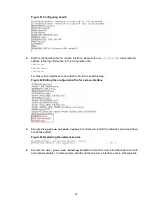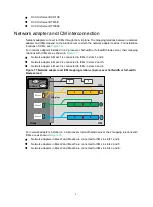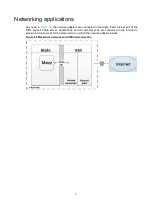
4
The network adapter supports 0 to 96 VFs for each PF.
VLAN (802.1Q VLAN)
Each port on the network adapter supports a maximum of 4094 VLANs.
A network adapter only transmits packets, and does not tag or untag packets. The VLAN ID is in the
range of 1 to 4094 and is assigned by the operating system.
VLAN refers to a group of logical devices and users working at Layer 2 and Layer 3. A VLAN is a
broadcast domain. Communication between VLANs is supported by Layer 3 routers. Compared with
LAN, VLAN has less adding and modification overhead and can control broadcasts to enhance
network security and bring flexibility.
BONDING (Linux)
BONDING has the following modes:
•
mode=0, round-robin policy (balance-rr)
—Transmits data packets between two slave
devices in sequence. This mode is used commonly.
•
mode=1, active-backup policy (active-backup)
—Only the master device is in active state. A
backup device takes over the services when the master device fails. This mode is used
commonly.
•
mode=2, XOR policy (balance-xor)
—Transmits data packets based on a specified
transmission hash policy.
•
mode=3, broadcast policy
—Transmits data packets out of each slave interface. This mode is
error tolerant.
•
mode=4, IEEE 802.3ad dynamic link aggregation (802.3ad)
—Creates an aggregation group
where group members share the same rated speed and full duplex mode settings. Slave device
selection for traffic output is based on transmission hash policy. In this mode, the switch must
support IEEE 802.3ad and have specific configurations.
•
mode=5, adaptive transmit load balancing (balance-tlb)
—Does not require specific
switches. This mode allocates outgoing traffic to slave devices according to the device loads. If
a slave device that is receiving traffic fails, another slave device takes over the MAC address of
the faulty slave device.
•
mode=6, adaptive load balancing (balance-alb)
—Does not require switches. This mode
integrates the balance-tlb mode and load balancing of IPv4 packet receiving. It is realized by
ARP negotiation. The BONDING driver intercepts the ARP replies sent by the local device and
changes the source MAC address into a unique MAC address of a slave device in the BOND,
allowing different peers to communicate with different MAC addresses. This mode is used
commonly.
Teaming (Windows)
This section uses the Windows Server 2012 R2 operating system as an example.
Typically, NIC Teaming has the following modes:
•
Static Teaming
—A switch-dependent mode in which member NICs must connect to the same
physical switch. This mode requires the support of switches.
•
Switch independent
—Member NICs can be connected to different switches in active/standby
mode. Load balancing aggregation can be realized only when the member NICs connect to the
same switch.
•
LACP
—You must enable LACP on the switch first. This mode integrates multiple NICs into one
logical link. Data is transmitted at the fastest speed in LACP mode.
Besides configuring the Teaming mode, you must also configure the load balancing mode. Load
balancing has the following modes:
•
Address Hash mode
—In this mode, when a packet arrives at Teaming, the device uses the
hash algorithm to calculate the packet sending physical NIC based on the destination address
information (MAC address, IP address, and port number). This mode cannot control traffic








































